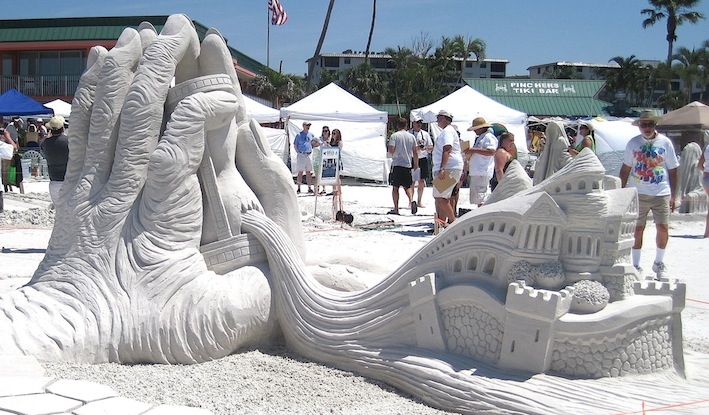What better time to take up a new outdoor hobby than the start of summer? And what better place to do it than at the beach? Petya Yankova looks at sandcastles in Europe.
It’s almost that time of the year again… blinding sunshine, salty water, sand between your toes. What could stir your imagination and inspire your creativity during the long-awaited holiday? What links the west coast of Denmark with the southernmost region of Portugal? What do Italy, Switzerland and Bulgaria have in common? What is inspired by themes as diverse as Icelandic legends, the Beatles, Columbus, Cyril and Methodius, Grimm’s fairytales, and the Italian Renaissance?
Sand sculpture festivals in Europe are a relatively new trend which seems to have taken over Europe’s beaches in the last 10 years. Boasting diverse themes, they offer a feast of creativity, an array of awe-inspiring figures made out of transient sand which yet remain untouched by the passage of months. Three-dimensional cartoon and fairytale characters are brought to life and every summer greet visitors in Rügen, Copenhagen, Jesolo, Zandvoort, Brno, Olomouc, Nitra, Rorschach, Burgas, Algarve, Blankenberge, to name just a few places.

Although famously practised by the ancient Egyptians, sand creations have become popular once again only in this century. The meaning attributed to sand and to sculpture could be a possible explanation for the revival of the forgotten art form. According to the aptly named sculptor and president of Baltic Association of Sand Sculpture, Sandis Kondrats, ‘sand as a material fits perfectly into the rhythm of the interconnected world of the 21st century and the ‘green’ sustainability concept.’ Furthermore, it is accessible and available to all, unlike the religious or royal sculptures from the 19th century. Mr Kondrats adds that sand art is also easily distinguishable from the political propaganda tool sculpture has become in the last century. Although they share the same art form, sand sculptures have nothing to do with the monumental grey figures which still haunt Eastern Europe’s squares. The political leaders of the past wanted to have their power linked and identified with the practically eternal and indestructible metal or concrete images of themselves. Sand sculptures today, however, emphasise the transience of life and the constant flux of time.
‘Sand sculptures are ephemeral art creations, and they last a very limited span of time. People are attracted to witness something which is created for a moment of being.’
The Czech sculptor Radovan Živný shares his views on why the medium of sand attracts so many art-lovers: ‘I believe that it touches the philosophy of life: our existence is limited, nothing lasts forever. The beauty of sand sculptures proves this 100%. Sand sculptures are ephemeral art-creations, and they last a very limited span of time. People are attracted to witness something which is created for a moment of being.’
Could there be another reason why thousands of visitors flock to the sand sculpture festivals every year? What makes sand sculpture festivals so popular? Why sand? Mr Kondrats explains: ‘People can relate to it in some ways, because everyone has played in the sand on the beach or has tried to create something. This might be the reason why sand art is so popular. Because of the temporary nature of the art form it is possible to bring and sculpt sand anywhere.’
Perhaps this is why between March and November every year many European cities and resorts turn into open-air granular fiestas of creativity. The festivals have themes as diverse as their locations: The World of Books, Music, Jungle, the Wild West, the Seven Wonders of the World, the Italian Renaissance, Myths and Legends, Wonderland, Circus, celebration of the life of the pirate Klaus Störtebeker, even a quote by the poet H.M. Enzensberger are all suitable themes for a sand sculpture festival. More adventurous visitors could explore an array of monsters and film villains, children could recognise their favourite cartoon and book characters, and history lovers could compare Greek mythology with Icelandic sagas. Some visitors might even snuggle up to a yellow-ish tanned Brad Pitt in a sandy bed.

If the visitors feel such a thrill in exploring such exhibitions, how do artists feel about their work? Mr Živný reveals: ‘This is a very subjective thing. I remember in my early years feelings of excitement, nervousness about the danger of the sculpture collapsing, and a big sense satisfaction if it did not happen. As I have been sculpting sand for over 15 years, my feelings have changed. These days I would describe them more as a complete concentration on the form of each piece, and a creative fight for transmitting my idea. Still, and maybe forever, pushing the limits of the material!The summer fiesta of sand creations seems to have revamped the European cultural heritage, and that includes literature, music, cinema, even (in)famous historical figures. A teenager who visited last year’s festival in Burgas admits that ‘it’s a great emotion to see this whole wonderful world of sand, all these figures come alive in front of your eyes…I think everyone who has even a slight interest in art should visit the festival’.
The summer fiesta of sand creations seems to have re-vamped the European cultural heritage, and that includes literature, music, cinema, even (in)famous historical figures.
The sand sculpture festivals offer additional attractions. If exploring a few thousand square metres of fantastic sand-creations has stirred your imaginations, why not try your hand at creating your own masterpiece? Many venues now provide a try-it-yourself area where visitors are presented with a box of sand to give their inspiration a three-dimensional form. Most of the festivals also offer guided tours and sand sculpting lessons. The festival in Søndervig, Denmark amazes its visitors with a story told on a sand wall over 200 metres long and 7 metres high, as well as detailed instructions on how to build your own sandcastle and sand sculpture. Brighton’s festival has found another way of attracting visitors. Famous for its musical scene, this year the sea resort has combined local artists with world famous sculptors under the theme of Music.
‘There is always someone bigger or smaller than you, even gods and ants know that,’ is the theme of the 15th International sand sculpture festival in Rorschach, Switzerland. The motto captures well the idea of sand sculpture festivals where the criteria of dimension and scale weigh just as much as originality and mastery do. The festivals in Zandvoort, the Netherlands, and Jesolo, Italy feature sand sculpting championships, and many of the European festivals allow visitors to observe the actual creative process behind the scenes which might take a few days, weeks, or even a few months. The largest sand sculpture festival in the world according to the Guinness Book of Records 2010 is also in Europe. The town of Blankenberge, Belgium welcomes some 20 000 tons of sand between June and September in order to create an enormous wonderland of sand.
What’s next? Sculptors and organisers seem to disagree on the future of sand festivals. Will they turn into commercialised attractions or will they preserve their high artistic merit? Mr. Kondrats believes that with sand sculpting emerging as an exciting professional art with whole TV series devoted to it, sand sculpture festivals are bound to continue as a popular European attraction. Another sculptor predicts a different future for the enormous open-air exhibitions. Radovan Živný observes that taking into account the several big festivals which closed down in the last years and the recent flourish of smaller scale events which are not so financially demanding, the future of sand art festivals seems unclear. Mr Živný also makes the valid point that repeating the same themes will eventually bore the visitors (this year four festivals in Europe overlap in terms of time and topic). He believes that in the future the European public will tend to appreciate the artistic merit rather than the commercial attraction of a sand sculpture festival.
Finally, if you are inspired not only to visit these festivals, but to discover the sculptor in you, don’t forget that the best sand sculptures are made with sand from a river as the grains cling to each other more easily.









